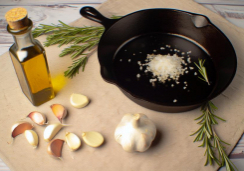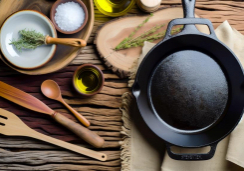Beginner's Guide to Healthier Stir-Fry Methods
Did you know that nearly 80% of Americans don't meet the recommended daily intake of vegetables? Incorporating more veggies into your diet can be both delicious and simple, especially when you master the art of stir-frying. As you embark on your journey to healthier eating, you'll find that stir-fry isn't just about tossing random ingredients into a hot pan.
It's a nuanced cooking method that, when done correctly, can transform your kitchen into a hub for nutritious and mouth-watering meals. You're probably wondering how you can achieve that perfect balance of crispy, yet tender vegetables and succulent proteins without resorting to excessive oils or sodium-laden sauces.
Stick with me, and you'll discover the secrets to elevating your stir-fry from ordinary to extraordinary, ensuring your dishes are not only packed with flavor but also aligned with your health goals.
Choosing Your Ingredients Wisely
When assembling the components for your stir-fry, opt for lean proteins such as chicken breast, beef sirloin, or tofu to create a dish that's both satisfying and health-conscious. Vegetables are the cornerstone of a nutrient-packed stir-fry, so include a vibrant mix like bell peppers, broccoli, snap peas, and carrots. These ingredients not only contribute a spectrum of vitamins and minerals but also add a satisfying crunch and burst of color to your meal.
As you prepare your stir-fry, consider the cooking method. Vegetables that take longer to cook, such as carrots and broccoli, should be added before those that cook quickly, like snap peas and bell peppers. Cutting ingredients into small pieces ensures they'll cook evenly and rapidly, locking in nutrients and flavors.
Be mindful of the amount of oil; a small amount is sufficient to sauté your ingredients effectively. When it comes to sauces, opt for low-sodium soy sauce or oyster sauce to enhance the taste without overwhelming the dish with salt.
Mastering the Stir-Fry Technique
Having selected the right ingredients, it's essential to hone your stir-fry technique to ensure each component is cooked to perfection, enhancing both the dish's nutritional value and flavor profile. To achieve a quick and healthy meal, heat the wok until it's very hot before adding oil; this high heat is crucial to sear the ingredients and lock in flavors.
Start by stir-frying proteins like chicken or tofu, ensuring they're sliced against the grain and tenderized for maximum tenderness and flavor absorption.
Next, add flavor with aromatic ingredients such as garlic, ginger, or green onions, which should be quickly sautéed to prevent burning. Prepping these ingredients in advance will help you cook food quickly and efficiently, a hallmark of Chinese cooking. Grace Young, a stir-fry guru, emphasizes the importance of this mise en place for a seamless process.
When adding vegetables for a vegetable stir fry, consider their cooking times. Denser vegetables like carrots might need a head start, while leafy greens are added last to retain their texture and nutritional integrity.
Don't be afraid to get creative with your stir-fry combinations; experimenting is how you'll personalize and master the stir-fry technique, making it a go-to method for healthful, flavorful meals.
Perfecting Protein Preparation
To elevate your stir-fry, it's crucial to give attention to how you prepare your proteins. Select quality sources and use proper slicing and tenderizing techniques to ensure they're flavorful and tender.
Whether you opt for chicken, beef, pork, seafood, tofu, or tempeh, each adds a unique profile to your dish.
When it comes to protein preparation, slice meat against the grain to enhance tenderness. This allows each piece to absorb flavors more readily. Tenderize with a fork or a meat mallet to ensure even cooking.
A key method of cooking proteins in stir-fries is to cook them separately from vegetables. This targets their specific needs, as proteins often require higher heat for a shorter period.
For a chicken stir-fry, for instance, cook the chicken on medium-high heat until it's just done to cook quickly without drying out. By cooking meat at a time and removing it from the pan before adding vegetables, you maintain distinct textures and flavors.
Prepping your proteins in advance streamlines the cooking process, ensuring that you can stir and toss at a lively pace. Don't shy away from marinating your proteins, as this step can deepen the taste and tenderize the fibers, making your stir-fries even more delectable.
Selecting the Right Cookware
Choosing the right cookware, particularly a well-crafted wok, is often the cornerstone of preparing a healthier stir-fry that's both nutrient-rich and flavorful. A wok with a wide bottom and deep, sloping sides ensures even heat distribution, providing ample space for your stir-fries. When selecting a wok, consider one made of carbon steel or cast iron. These materials are celebrated for their durability and superior heat retention.
Opt for a wok with a flat bottom if you're cooking on a gas, electric, or induction stovetop. This design allows for stability and versatility across various cooking surfaces. Additionally, a non-stick wok can be a wise choice to minimize oil usage and facilitate easier cleanup, letting you cook and eat without the worry of troublesome washing later.
To maneuver your food quickly and effectively, look for a wok with a long handle and a loop handle. This combination provides control and ease of handling. Before adding sauce ingredients or proteins, always preheat your wok until it's hot. This technique ensures that your ingredients sear beautifully rather than steam.
Lastly, equip yourself with the proper utensils, like a wooden spoon or a wok ladle, to stir and scoop with ease, protecting the integrity of your wok's surface and your delicious, health-conscious creations.
What Are Some Healthier Stir-Fry Methods for Beginners?
When it comes to easy healthy stir-fry methods for beginners, choosing the right oils and incorporating plenty of colorful vegetables is key. Stick to lighter oils like olive or avocado, and consider using broth instead. Opt for lean proteins and go easy on the sodium to keep your stir-fry healthy and delicious.
Flavoring With Healthy Sauces
As you craft your stir-fry, incorporating a variety of healthy sauces can elevate the dish's flavor profile while maintaining its nutritional value. Start with basic pantry staples like soy sauce, rice vinegar, and a touch of brown sugar to create a foundational stir-fry sauce that's both tasty and health-conscious. Stir-frying in a wok allows for quick cooking and even distribution of these flavors, ensuring your chicken and vegetables are coated perfectly.
When experimenting with sauces, consider oyster sauce for umami depth or a dash of teriyaki for a savory-sweet glaze. If heat is your preference, a bit of hot sauce can provide a zesty kick. Don't shy away from herbs and spices; garlic and ginger offer a fragrant accent, while chili flakes can dial up the intensity.
Conclusion
Now you've got the scoop on sizzling up a healthier stir-fry!
Remember, it's all about picking fresh, nutrient-packed ingredients, getting your stir-fry technique on point, prepping your protein smartly, choosing the right cookware, and flavoring with sauces that are big on taste but light on excess sodium and sugars.
Stick to these tips, and you'll be dishing out vibrant, healthful stir-fries that are as good for your body as they're delicious.
Keep stirring and stay healthy!










